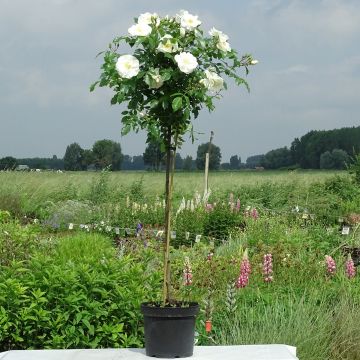

Rosa The Fairy - Standard Rose
Rosa The Fairy - Standard Rose
Rosa x polyantha The Fairy (Féérie)
Polyantha Rose
This item cannot be shipped to the selected country
Oversize package delivery charge from €6.90
Oversize package delivery charge from €6.90
Oversize package delivery charge from €6.90
Oversize package delivery charge from €6.90
Delivery to Corse prohibited
More information
Schedule delivery date,
and select date in basket
This plant carries a 24 months recovery warranty
More information
We guarantee the quality of our plants for a full growing cycle, and will replace at our expense any plant that fails to recover under normal climatic and planting conditions.
Oversize package: home delivery by special carrier from €6.90 per order..
Express home delivery from €8.90.
Oversize package: home delivery by special carrier from €6.90 per order..
Express home delivery from €8.90.
Oversize package: home delivery by special carrier from €6.90 per order..
Express home delivery from €8.90.
Oversize package: home delivery by special carrier from €6.90 per order..
Express home delivery from €8.90.
Delivery to Corse prohibited: UE law prohibits the import of this plant from mainland France to Corse as part of the fight against Xylella fastidiosa. Please accept our sincere apologies.
More information

Does this plant fit my garden?
Set up your Plantfit profile →
Description
The 'The Fairy' standard rose possesses all the qualities of this beautiful creation, but it forms a delightful little tree crowned with a ball of double pink flowers throughout the summer. Appreciated for the generosity of its flowering, in bouquets of double flowers in a fresh and bright pink that fades slightly during the season, this rose also dresses itself in very healthy and abundant foliage. Almost fail-safe and easy to maintain, The Fairy is recommended for beginner gardeners.
Standard roses are created through the process of grafting. This involves taking a variety of rose, such as The Fairy, and attaching it to an upright stem that belongs to a different type of rose, either Rosa laxa or R. multiflora. The graft is usually performed at a height of around 50-60 cm (20-24in) from the ground. In regions with very cold winters, it may be necessary to protect the rootstock to ensure the plant's survival.
The flowers of Rosa x polyantha The Fairy are gathered in terminal clusters and come from the polyantha rose, an old hybrid resulting from Rosa multiflora and Rosa chinensis. The crown that develops on the stem shows a flexible and spreading bushy habit, slightly wider than tall. The flowers in small 3 cm (1in) pompons, double, in the shape of rosettes, barely fragrant, are of a bright pink, becoming soft pink at the end of flowering and blossoming in huge numbers in large pyramidal clusters, from July to October-November, as long as it does not freeze. This vigorous and disease-resistant variety develops fine, bronze-green, semi-evergreen foliage, more or less matte to slightly glossy. Its reddish stems bear thorns.
Created by Bentall in 1932.
The 'The Fairy' standard rose is ideally planted as a focal point in the centre of a bed, among perennials or low bushes, in a row along a pathway, near a terrace, or even in a large pot on the balcony. It can also be planted in groups of 3 specimens, arranged in a triangle, or as a solitary plant on a lawn. It pairs well with perennial geraniums (Geranium Blue Cloud, Anne Folkard, Nimbus, Orion), bellflowers (lactiflora, rapunculoides), catmints, snapdragons, foxgloves. Standard roses are perfect for adding volume to the bush, or ground-cover rose beds.
Report an error about the product description
Rosa The Fairy - Standard Rose in pictures




Plant habit
Flowering
Foliage
Botanical data
Rosa
x polyantha
The Fairy (Féérie)
Rosaceae
Polyantha Rose
Cultivar or hybrid
Rosa canina Laxa (Wrapped bare root, Wrapped bare root)
Other Tree Roses - Stem Roses
Planting and care
Roses thrive in a sunny location that receives at least 4 to 5 hours of sunlight per day but they should be sheltered from the burning rays of midday and strong winds. They grow best in loose, permeable, and humus-rich soil, that is slightly acidic but can adapt to any garden as long as the soil is well-worked and sufficiently rich. To plant a rose in a pot, first, work the soil to a depth of 25 cm (10in) and crumble it well. Place a bottom amendment such as blood, fish and bone in the planting hole, then position the plant, freed from its pot, covering the top of the root ball with 3 cm (1in) of soil and fill in. Water generously to eliminate air pockets and water regularly for a few weeks in dry weather to facilitate root growth. Also, remember to provide your rose with a special rose fertiliser that stimulates plant flowering. If you want abundant flowering of your climbing roses, regularly bend and tie the branches that can grow up to 1 m (3ft) a week during summer. Each bend leads to lateral growth that ends in a cluster of flowers. This technique is highly recommended and will lead to a more rewarding experience.
In regions with very cold winters, protecting the trunk of standard roses (the "trunk") is advisable by wrapping it in a thick winter cover.
Roses may develop unsightly spots at the end of summer, but this is a natural occurrence and doesn't harm the rose's growth.
Planting period
Intended location
Care
This item has not been reviewed yet - be the first to leave a review about it.
Roses by purpose
Haven't found what you were looking for?
Hardiness is the lowest winter temperature a plant can endure without suffering serious damage or even dying. However, hardiness is affected by location (a sheltered area, such as a patio), protection (winter cover) and soil type (hardiness is improved by well-drained soil).

Photo Sharing Terms & Conditions
In order to encourage gardeners to interact and share their experiences, Promesse de fleurs offers various media enabling content to be uploaded onto its Site - in particular via the ‘Photo sharing’ module.
The User agrees to refrain from:
- Posting any content that is illegal, prejudicial, insulting, racist, inciteful to hatred, revisionist, contrary to public decency, that infringes on privacy or on the privacy rights of third parties, in particular the publicity rights of persons and goods, intellectual property rights, or the right to privacy.
- Submitting content on behalf of a third party;
- Impersonate the identity of a third party and/or publish any personal information about a third party;
In general, the User undertakes to refrain from any unethical behaviour.
All Content (in particular text, comments, files, images, photos, videos, creative works, etc.), which may be subject to property or intellectual property rights, image or other private rights, shall remain the property of the User, subject to the limited rights granted by the terms of the licence granted by Promesse de fleurs as stated below. Users are at liberty to publish or not to publish such Content on the Site, notably via the ‘Photo Sharing’ facility, and accept that this Content shall be made public and freely accessible, notably on the Internet.
Users further acknowledge, undertake to have ,and guarantee that they hold all necessary rights and permissions to publish such material on the Site, in particular with regard to the legislation in force pertaining to any privacy, property, intellectual property, image, or contractual rights, or rights of any other nature. By publishing such Content on the Site, Users acknowledge accepting full liability as publishers of the Content within the meaning of the law, and grant Promesse de fleurs, free of charge, an inclusive, worldwide licence for the said Content for the entire duration of its publication, including all reproduction, representation, up/downloading, displaying, performing, transmission, and storage rights.
Users also grant permission for their name to be linked to the Content and accept that this link may not always be made available.
By engaging in posting material, Users consent to their Content becoming automatically accessible on the Internet, in particular on other sites and/or blogs and/or web pages of the Promesse de fleurs site, including in particular social pages and the Promesse de fleurs catalogue.
Users may secure the removal of entrusted content free of charge by issuing a simple request via our contact form.
The flowering period indicated on our website applies to countries and regions located in USDA zone 8 (France, the United Kingdom, Ireland, the Netherlands, etc.)
It will vary according to where you live:
- In zones 9 to 10 (Italy, Spain, Greece, etc.), flowering will occur about 2 to 4 weeks earlier.
- In zones 6 to 7 (Germany, Poland, Slovenia, and lower mountainous regions), flowering will be delayed by 2 to 3 weeks.
- In zone 5 (Central Europe, Scandinavia), blooming will be delayed by 3 to 5 weeks.
In temperate climates, pruning of spring-flowering shrubs (forsythia, spireas, etc.) should be done just after flowering.
Pruning of summer-flowering shrubs (Indian Lilac, Perovskia, etc.) can be done in winter or spring.
In cold regions as well as with frost-sensitive plants, avoid pruning too early when severe frosts may still occur.
The planting period indicated on our website applies to countries and regions located in USDA zone 8 (France, United Kingdom, Ireland, Netherlands).
It will vary according to where you live:
- In Mediterranean zones (Marseille, Madrid, Milan, etc.), autumn and winter are the best planting periods.
- In continental zones (Strasbourg, Munich, Vienna, etc.), delay planting by 2 to 3 weeks in spring and bring it forward by 2 to 4 weeks in autumn.
- In mountainous regions (the Alps, Pyrenees, Carpathians, etc.), it is best to plant in late spring (May-June) or late summer (August-September).
The harvesting period indicated on our website applies to countries and regions in USDA zone 8 (France, England, Ireland, the Netherlands).
In colder areas (Scandinavia, Poland, Austria...) fruit and vegetable harvests are likely to be delayed by 3-4 weeks.
In warmer areas (Italy, Spain, Greece, etc.), harvesting will probably take place earlier, depending on weather conditions.
The sowing periods indicated on our website apply to countries and regions within USDA Zone 8 (France, UK, Ireland, Netherlands).
In colder areas (Scandinavia, Poland, Austria...), delay any outdoor sowing by 3-4 weeks, or sow under glass.
In warmer climes (Italy, Spain, Greece, etc.), bring outdoor sowing forward by a few weeks.




















































